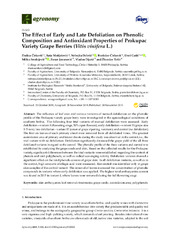Приказ основних података о документу
The Effect of Early and Late Defoliation on Phenolic Composition and Antioxidant Properties of Prokupac Variety Grape Berries (Vitis vinifera L.)
| dc.creator | Cirković, Dušica | |
| dc.creator | Matijašević, Saša | |
| dc.creator | Deletić, Nebojša | |
| dc.creator | Cirković, Bratislav | |
| dc.creator | Gašić, Uroš M. | |
| dc.creator | Sredojević, Milica | |
| dc.creator | Jovanović, Zoran | |
| dc.creator | Djurić, Vladan | |
| dc.creator | Tešić, Živoslav | |
| dc.date.accessioned | 2020-12-17T22:33:05Z | |
| dc.date.available | 2020-12-17T22:33:05Z | |
| dc.date.issued | 2019 | |
| dc.identifier.issn | 2073-4395 | |
| dc.identifier.uri | http://aspace.agrif.bg.ac.rs/handle/123456789/4982 | |
| dc.description.abstract | The influence of leaf area and various variants of manual defoliation on the phenolic profile of the Prokupac variety grape berry were investigated in the agroecological conditions of southern Serbia. The following four trial variants of manual defoliation were assessed: Early defoliation-variant I (flowering stage, 50% open flowers); early defoliation-variant II (grape size 3-5 mm); late defoliation-variant III (onset of grape ripening, veraison); and control (no defoliation). The first six leaves of each primary shoot were removed from all defoliated vines. The greatest assimilation area of primary and lateral shoots during the study was observed in the control, i.e., the trial variant with no defoliation. Defoliation significantly decreased the grape yield of the all three defoliated variants in regard to the control. The phenolic profile of the three variants and control was established by analyzing the grape seeds and skin. Based on the collected results for the Prokupac variety, significant differences between the trial variants were established regarding the content of phenols and total polyphenols, as well as radical scavenging activity. Defoliation variants showed a significant effect on the total phenols content of grape skin. In all defoliation variants, as well as in the control, high amounts of ellagic acid were measured. Resveratrol was identified only in grape skin samples of the control variant. The removal of leaves increased the concentration of phenolic compounds in variants where early defoliation was applied. The highest total anthocyanins content was found in 2015 in variant I, where leaves were removed during the full flowering stage. | en |
| dc.publisher | MDPI, BASEL | |
| dc.relation | info:eu-repo/grantAgreement/MESTD/Basic Research (BR or ON)/172017/RS// | |
| dc.rights | openAccess | |
| dc.rights.uri | https://creativecommons.org/licenses/by/4.0/ | |
| dc.source | Agronomy-Basel | |
| dc.subject | skin anthocyanin | en |
| dc.subject | leaf removal | en |
| dc.subject | treatments | en |
| dc.subject | grape seeds | en |
| dc.subject | assimilation area | en |
| dc.subject | polyphenols | en |
| dc.title | The Effect of Early and Late Defoliation on Phenolic Composition and Antioxidant Properties of Prokupac Variety Grape Berries (Vitis vinifera L.) | en |
| dc.type | article | |
| dc.rights.license | BY | |
| dc.citation.issue | 12 | |
| dc.citation.other | 9(12): - | |
| dc.citation.rank | M21 | |
| dc.citation.volume | 9 | |
| dc.identifier.doi | 10.3390/agronomy9120822 | |
| dc.identifier.fulltext | http://aspace.agrif.bg.ac.rs/bitstream/id/3491/4979.pdf | |
| dc.identifier.scopus | 2-s2.0-85076277617 | |
| dc.identifier.wos | 000507280400066 | |
| dc.type.version | publishedVersion |


